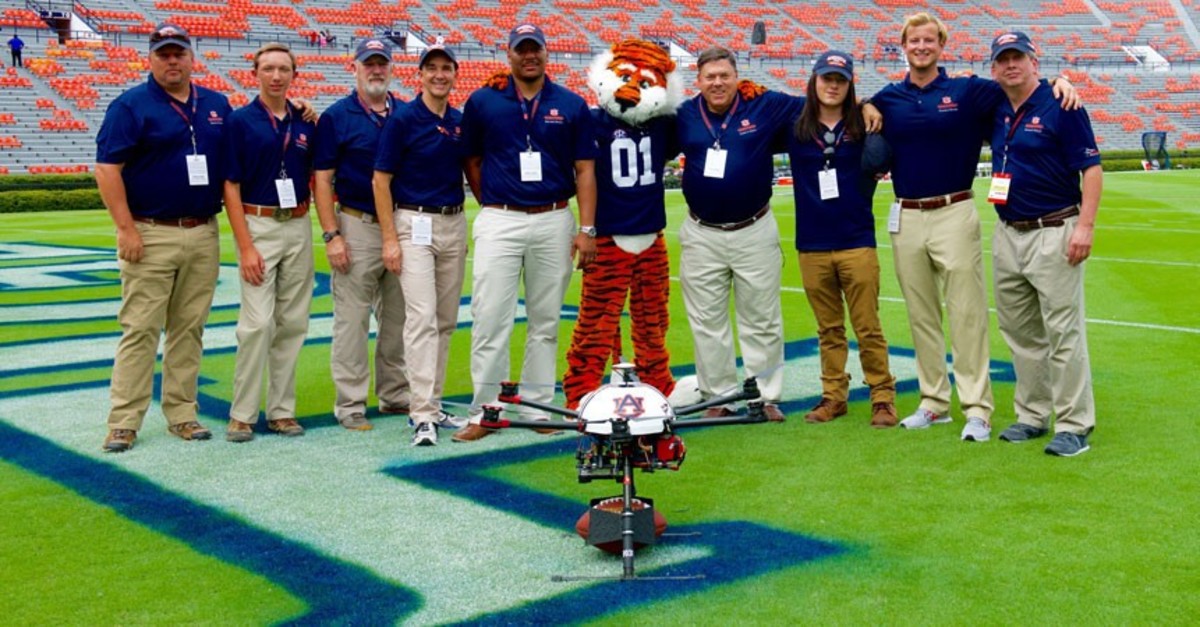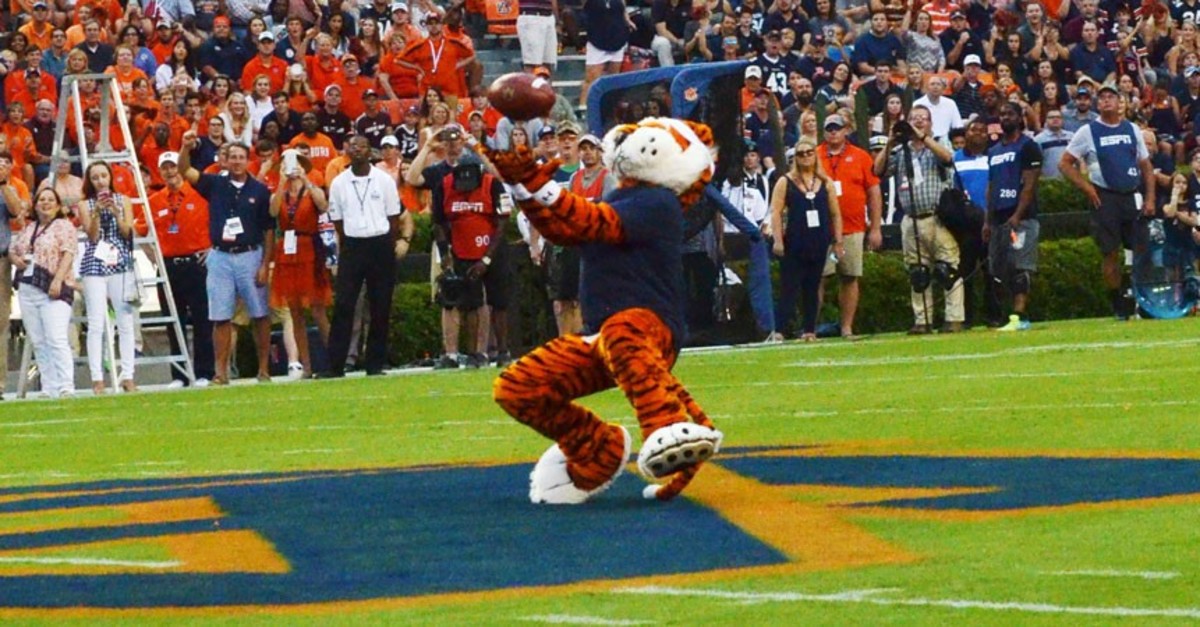War Damn ... Drone? Inside Auburn's unique decision to include a drone into its famed pregame ritual

A staple of Auburn's home games, the trademark "Waaaaaar Eagle" battle cry, breaks out among the orange-and-blue faithful. It's yelled when either Nova or Spirit, Auburn's pair of live eagle mascots, circles the field just prior to kickoff and divebombs the logo in the middle of Jordan-Hare Stadium.
But today, it's being yelled twice. Once for the eagle, and once for a drone.
"It's part of the crescendo, it's to get the crowd going," said Bill Hutto, director of the Auburn University Aviation Center. "The cheerleaders are actually working with us on it. When we take off, they start a 'War Eagle'"
The drone, a DJI-s900 model that is specifically designed to resemble an Auburn football helmet—complete with actual decals from the athletic department—cradles the game ball underneath its lightweight carbon-fiber frame.
It lifts off from the south end zone, flies to the opposite end of the field, and hovers some 80 feet above midfield before releasing the ball into the waiting arms of Aubie—Auburn's costumed tiger mascot—below, while the crowd punctuates the "War Eagle!" chant with a louder "Hey!" that coincides with the ball reaching its destination.
The game ball just got delivered by a drone. That's...unique. #CampusRush pic.twitter.com/POo6XIzRzu
— Sam Butler (@_sam_butler) September 17, 2016
The ritual, which has been a part of each home game this season, was in the works for just under a year. It emerged because of Auburn's storied history in aviation education—aerospace classes began in as early as 1910—and because Auburn was the first flight school, public or private, to be certified by the FAA to operate Unmanned Aircraft Systems.
So with that distinction, the decision to showcase Auburn's relatively new program—and drones, which are still novel to many people—in the biggest stage possible was a no-brainer.
"We just saw this as a natural extension of what we've been doing for almost a century, or over a century in some cases," Hutto said. "We have an administration that's very interested in aviation, very supportive of aviation, so the administration and the university approached us and said, 'Hey, we think this would be a good idea.'"
Despite the enthusiasm, there were still challenges to make it happen and a load of safety regulations. To even fly a drone in Jordan-Hare Stadium required a waiver from the FAA, because on gamedays, the stadium has what's called a Temporary Flight Restriction around it because it holds more than 35,000 people.

Courtesy of Sam Butler
Hutto and Earle Thompson, a retired fighter pilot of 36 years who now teaches in Auburn's aviation program, submitted a 12-page "How it's Gonna Go" document to the FAA, which now stands at 43 pages because the safety parameters are so extensive and far-reaching.
And that's just the paperwork. Behind the scenes, there's even more preparation.
Hutto, Thompson, and the rest of the team arrive at the stadium two hours before the gates open to do a test flight in order to ensure everything is functioning properly. Then, when the time comes to actually operate the drone and deliver the game ball, everyone but Aubie, the controller and four spotters—one on each side of either 10-yard line—take their marks.
They can't communicate verbally, because Jordan-Hare Stadium, which is notorious for being one of the loudest stadiums in the country, can make it difficult to get even basic messages across otherwise.
"Flying it all the way down to the other end of the end zone, with your depth perception, you don't understand how close you are," Thompson said. "We're actually using hand signals so we're staying where we want to stay and making sure we're maneuvering properly.
DRONE BACK #CampusRush pic.twitter.com/Avb60Geyh6
— Sam Butler (@_sam_butler) September 24, 2016
The people who actually control the drone are subject to currency requirements just as they would if they were flying an airplane. "We've got very good confidence in what we're doing because we've taken a very safe approach to this to make sure we're not going to allow it to get out of sight and the boundaries where we want to fly it."
Piloting the drone for practice in a field somewhere gets easy, especially for someone who is qualified enough to operate a complicated maneuver like lining it up 80 feet over its intended target. But no matter how much practice you put in, there's nothing that will prepare you for being alone in front of a stadium full of screaming fans.
"There's a lot of pressure when you get out there in front of 87,000 people in there, and the president and the provost and other people are up in the skyboxes that donate plenty of money to the university seeing what we're doing," Thompson said. "You want to put on a good show and you want it to be right and come off well. So far it has."
The operator pilots the drone down the field, but he'll change it up to something other than a straight line down and back, because "we don't want to be stale," Hutto said.

Courtesy of Sam Butler
Once Aubie catches the ball—well, sometimes, since he's 2-for-3 so far—the drone returns to its landing spot and is placed in a climate-controlled environment to help it cool down and keep from overheating.
For all the preparation, practice and backstage work that takes place beforehand, the process itself is over in just a few minutes. The interest it attracts though, even in that brief period of time, is substantial.
"There was a lady sitting in front of us, and I had my Auburn University Aviation shirt on," Hutto said. "She said, 'Are you part of the group? I want you to talk to my son.' He was 10 or 12 years old, and he was just in awe of what could happen. So just the opportunity to talk to him about science and math and 'Yes, you can achieve your dreams by doing things.'"
There have been some questions, however. And among the ones everyone wants to know is what seems like a no-brainer.
"People say, 'Why don't you fly with the eagle,'" Thompson said. "And I don't think we want to do that."
Disappointment soon follows, but there's a pretty good reason it can't happen.
"The eagle might see it as a threat."
Sam Butler is SI's campus correspondent for Auburn University. Follow him on Twitter.
